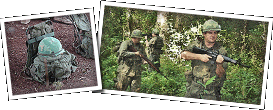CHAPTER 21
IMMEDIATE ACTION DRILLS FOR FOOT PATROLS
From Combat Training of the Individual Soldier and Patrolling, July 1967
Section I. INTRODUCTION
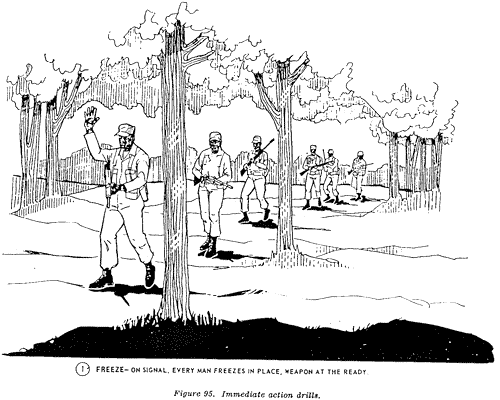
- Application
This chapter describes and discusses immediate action drills as they can be developed and used by foot patrols. They can, however, be just as profitably developed and used by any dismounted small unit. The same principles, with techniques appropriately modified, can be applied to immediate action drills for mounted units.
- General
- A patrol may make contact with the enemy at any time. This is especially true in counter-guerrilla operations where . the enemy is more dispersed and elusive than in conventional operations. Contact may be through chance contact, air observation or attack, or ambush. Contact may be visual contact only in which the patrol sights the enemy but is not itself detected. When this is the case, the patrol leader can decide whether to make or avoid physical contact, basing his decision on the patrol's assigned mission and capability to successfully engage the potential target.
- When a patrol's assigned mission prohibits physical contact, except that necessary to accomplish the mission, its actions are defensive in nature. It avoids even being seen by the enemy. Physical contact, if unavoidable, is broken as quickly as possible and the patrol, if still capable, continues its mission.
- When a patrol's assigned mission permits or requires it to seek or exploit opportunities for contact (as in the case of a. search and attack patrol), its actions are offensive in nature and are immediate and positive.
- In foot patrolling, especially in counter-guerrilla operations, contacts (visual or physical) are often unexpected, at very close ranges, and short in duration. Effective fire, or the threat of effective fire, often provides leaders little or no time to fully estimate situations and issue orders. In these situations, immediate action drills provide a means for swiftly initiating positive offensive or defensive action, as appropriate.
- Immediate Action Drills
- Immediate action drills are drills designed
to provide swift and positive small unit reaction
10 enemy visual or physical contact,. They are
simple courses of action in which all men are so
well trained that minimum signals or commands
are required to initiate action. Immediate action
drills—
- Can be designed, developed, and used by any unit, no matter how it is organized.
- Are designed and developed as needed for the combat situation.
- Can, in many cases, be initiated by any member of the unit.
- Can also be designed, developed, and used by mounted and airmobile units.
- Immediate action drills are appropriate—
- When ambushed, regardless of terrain.
- When contact, including ambush, is at very close range and maneuver is restricted because of close terrain, such as mountains, jungle, or heavy woods.
- When detection by air observation is a threat.
- When under low level air attack.
- It is not feasible to attempt to design an immediate action drill to cover every possible situation. It is better to know one immediate action drill for each of a limited number of situations occurring in a combat area.
- Immediate action drills are drills designed
to provide swift and positive small unit reaction
10 enemy visual or physical contact,. They are
simple courses of action in which all men are so
well trained that minimum signals or commands
are required to initiate action. Immediate action
drills—
- Signals
- Some immediate action drills, such as the counter-ambush immediate action drills described below, are initiated without signals or commands, as pre-arranged automatic reactions to enemy contact. Others, such as the chance contact immediate action drill, immediate assault, are initiated on silent (arm-and-hand) signals. The standard silent signals contained in FM 21-60 are used, when appropriate. When these are not appropriate, special silent signals are developed and used.
- There are no standard silent signals for freeze, hasty ambush, and all clear. The standard silent signals for halt and enemy in sight (with direction indicated) require exaggerated arm motions which increase the danger of detection.
- The special silent signals shown in figure 94 may be used to halt a patrol in place, to indicate detection and direction of the enemy, to initiate. the drills discussed here, and to indicate that all is clear.
- Units designing other immediate action
drills should devise and use special silent signals
only when there are no appropriate standard
signals.

- Scope
- This chapter describes seven immediate. action drills: one for any situation required immediate halt, one for avoiding air observation one for air attack, two for chance contact, and two for countering ambush. It is a guide to users in designing and developing immediate action drills appropriate to their situations. The drills and other actions described and discussed are examples which, illustrate the application of principles and are not to be considered as standardized reactions which fit every situation.
- Normal small unit tactics and techniques are used in executing immediate action drills and are not discussed in detail.
Section II. EXAMPLE IMMEDIATE ACTION DRILLS
- Immediate Halt Drill
When the situation requires the immediate, in place halt of the patrol, the immediate action drill freeze is used. This is the situation when the patrol detects the enemy but is not itself detected. The first man detecting the enemy (visually or otherwise) gives the special silent signal. FREEZE. Every man halts in place. weapon at the ready, and remains absolutely motionless and quiet until further signals or orders are given.
- Air Observation and/or Attack Drills
These drills are designed to reduce the danger of detection by aircraft and casualties from low level air attack.
- Air Observation. When an aircraft, enemy or unidentified, which may detect the patrol is heard or observed, the appropriate immediate action drill is FREEZE. The first man hearing or sighting an aircraft which may be a. threat signals FREEZE. Every man freezes in place •until the patrol leader identifies the aircraft and gives further signals or orders.
- Air Attack. When an aircraft detects a
patrol and makes a low level attack, the immediate action drill air
attack is used. The first man sighting an attacking aircraft shouts, "Aircraft;
Front (Left, Rear, or Right)." Patrol
moves quickly into line formation, well spread
out, at right angles to the aircraft's direction
of travel. This is to deny the attacker a linear
target. As each man comes on line, he hits the
ground, using available cover. He positions his
body at right angles to the aircraft's direction
of travel, to present the shallowest target possible.
- Between attacks (if the aircraft returns or if more than one aircraft attacks) men seek better cover.
- Attacking aircraft are fired on only on command of the patrol leader.
- Chance Contact Drills
- Hasty Ambush. This immediate action drill is both a defensive measure used to avoid contact and an offensive measure to make contact. It may often be a subsequent action freeze. When special silent signal hasty ambush is given (by point, patrol leader, or another authorized man), the entire patrol moves quickly to the right or left of line of movement, as indicated by signal, and takes up the best available concealed firing positions. The patrol leader initiates am bush by opening fire and shouting, "Fire." This insures initiation of the ambush if his weapon misfires. If the patrol is detected before this, the first man aware of detection initiates ambush by firing and shouting.
- When used as a defensive measure to avoid contact, ambush is not initiated unless the patrol is detected.
- When used as an offensive measure, the enemy is allowed to advance until he is in the most vulnerable position before the ambush is initiated.
- An alternate means for initiating the ambush is to designate an individual (for example, point or last man) to open fire a certain portion of the enemy reaches or passes him.
- Immediate Assault. This immediate action drill is used, defensively, to make and quickly break undesired but unavoidable contact (including ambush), and, offensively, to decisively engage the enemy (including ambush). When used in chance contact, men nearest the enemy open fire and shout, "Contact, Front (Right, Left, or Rear)." The patrol moves swiftly into line formation and assaults.
- When used defensively, the assault is stopped if the enemy withdraws and contact is broken quickly. If the enemy stands fast, the assault is carried through enemy positions and movement is continued until contact is broken.
- When used offensively, the enemy is decisively engaged. Any one attempting to escape is pursued and destroyed.
- Counter-ambush Drills
When a patrol is ambushed, the immediate action drill used is determined by whether the ambush is near or far (see ch 16 for discussion of near and far ambushes).
- In a near ambush, the killing zone is under
very heavy, highly concentrated, close-range fires.
There is little time or space for men to maneuver
or seek cover. The longer they remain in the
killing zone, the more certain their destruction.
Therefore, if attacked by a near ambush react
as follows:
- Men in the killing zone, without order or signal, immediately assault directly into the ambush position, occupy it, and continue the attack or break contact, as directed. This action moves them out of the killing zone, prevents other elements of the ambush from firing on them without firing on their own men, and provides positions from which other actions may be taken.
- Men not in the killing zone maneuver against the attack force and other elements of the ambush, as directed.
- The attack is continued to eliminate the ambush or to break contact as directed.
- In a far ambush, the killing zone is also
under very heavy, highly concentrated fires, but
from a greater range. This greater range provides men in the killing
zone some space for maneuver and some opportunity to seek cover at
a lesser risk of destruction. Therefore, if attacked by a far ambush
react as follows;
- Men in the killing zone, without order or signal, immediately return fire, take the best available positions, and continue firing until directed otherwise.
- Men not in the killing zone maneuver against the ambush force, as directed.
- The attack is continued to eliminate the ambush or to break contact, as directed.
- In each situation, the success of the counter-ambush drill employed is dependent on the men being well trained in recognizing the nature of an ambush and well rehearsed in the proper reaction.
- Typical Situations, Appropriate Immediate Action Drills, and Subsequent Actions
In chance contact and in ambush, the immediate action drills a patrol uses and the patrol's subsequent actions are determined largely by whether the assigned mission prohibits or permits contact (except that necessary to accomplish the mission). The immediate action drill FREEZE, however, can be used in either circumstance and the use of the aircraft observation or attack immediate action drills and not affected by the assigned mission.
- Mission requires patrol to avoid contact, if
possible, and to quickly break any contact made.
- Situation. Patrol sees enemy approaching. Possibility appears
good that. enemy will not detect patrol. Enemy
is so close that there is no time to
establish a hasty ambush.
- Immediate action drill. FREEZE. Patrol opens fire only if detected.
- Subsequent action. If no contact, patrol continues after
enemy passes. If contact is made, it is broken by assault
or by clock system after initial fire,
and patrol continues (1, 2, fig. 95).

- Situation. Patrol sees enemy approaching. Contact appears unavoidable.
- Immediate action drill. FREEZE, followed by HASTY AMBUSH. Patrol executes ambush only if detected.
- Subsequent action. If no contact,
patrol continues after enemy passes.
If ambush is executed, patrol assaults by fire only, withdraws quickly,
and continues (3, 4, fig. 95).
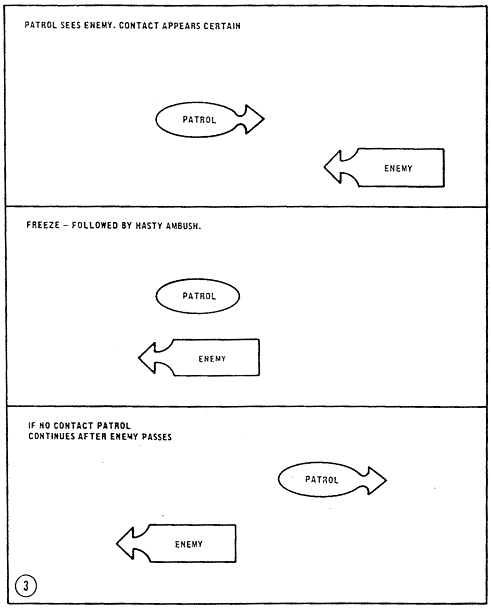
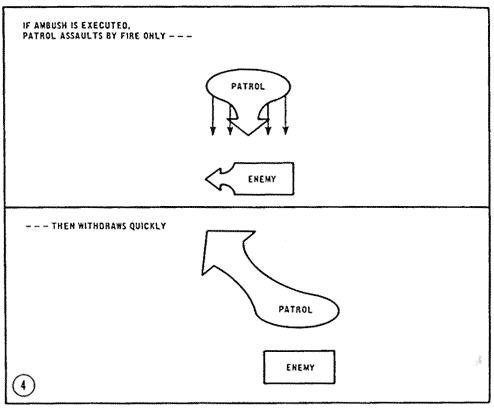
- Situation. Patrol and enemy detect each
other at same time and at such close
range that breaking by clock system or
fire and maneuver is not appropriate.
- Immediate action drill. IMMEDIATE ASSAULT, to enemy, if he withdraws; through enemy if he stands fast (5, 6, fig. 98).
- Subsequent action. Continue mission.
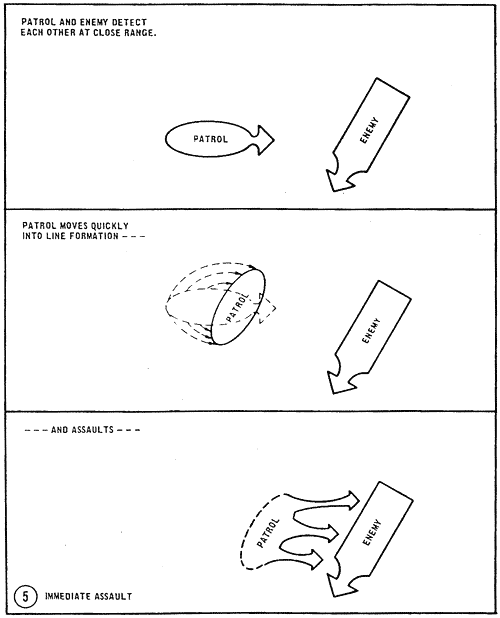

- Situation. Patrol is ambushed (near
ambush).
- Immediate action drill. COUNTER-AMBUSH. Men in killing zone assault attack force. Other men attack, as directed, to permit entire patrol to break contact (7, 8, fig. 95).
- Subsequent action. Reorganize and
continue mission.
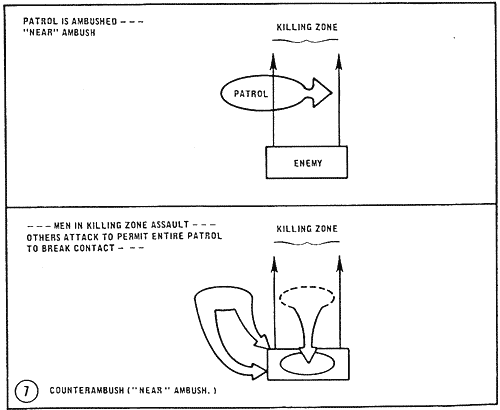

- Situation. Patrol is ambushed (far ambush).
- Immediate action drill. COUNTER- AMBUSH. Men in killing zone return fire, seek cover, continue firing. Other men attack, as directed, to permit patrol to break contact (9, 10, fig. 95).
- Subsequent action. Reorganize and
continue mission.
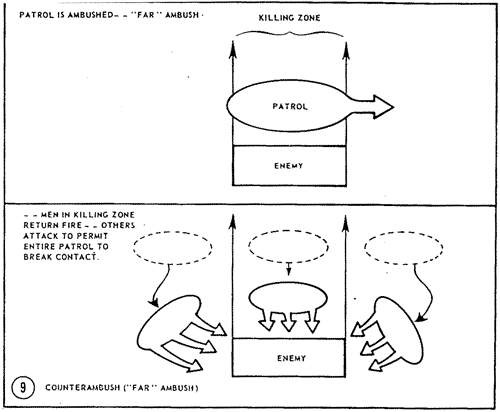
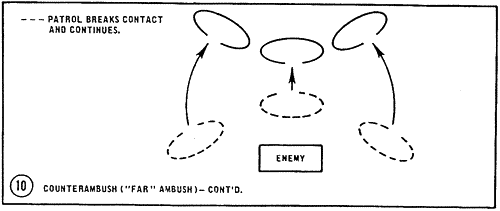
- Situation. Patrol sees enemy approaching. Possibility appears
good that. enemy will not detect patrol. Enemy
is so close that there is no time to
establish a hasty ambush.
- Mission requires patrol to engage targets of
opportunity and otherwise exploit opportunities
to engage in decisive combat.
- Situation. Patrol sees enemy approaching. Possibility appears
good that the enemy will not detect patrol. Enemy is
so close that there is no time to establish
a hasty ambush.
- Immediate action drill. FREEZE.
- Subsequent action. Patrol allows
enemy to advance as close as possible.
Patrol leader opens fire when enemy
is in most vulnerable position (any
patrol member opens fire if detected).
Patrol assaults with great violence
and heavy fire; destroys enemy; pursues if appropriate (11, 12,
fig. 95).
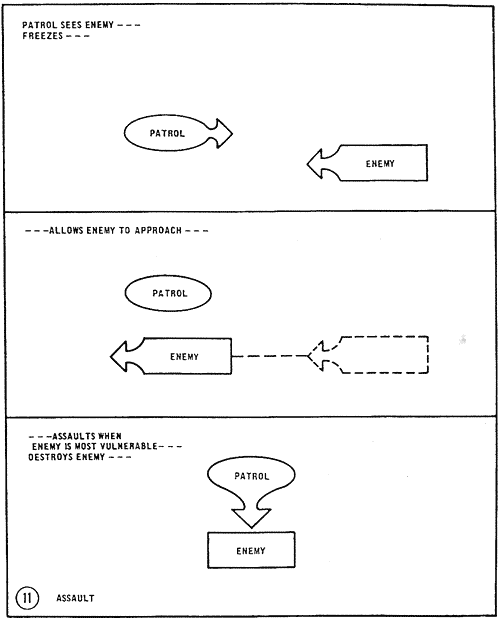
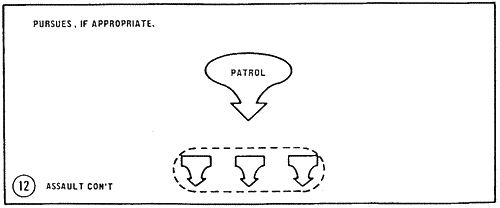
- Situation. Patrol sees enemy approaching. Contact appears unavoidable.
- Immediate action drill. FREEZE, followed by HASTY AMBUSH.
- Subsequent action. Patrol executes
ambush when enemy is in most vulnerable position; assaults
with great violence and heavy fire; destroys
enemy; pursues if appropriate (13,
14, fig. 95).

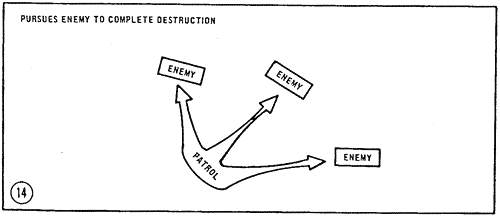
- Situation. Patrol and enemy detect
each other at same time.
- Immediate action drill. IMMEDIATE ASSAULT.
- Subsequent action. Patrol continues
assault until enemy is destroyed.
Escaping enemy is pursued and destroyed (15, fig. 95);
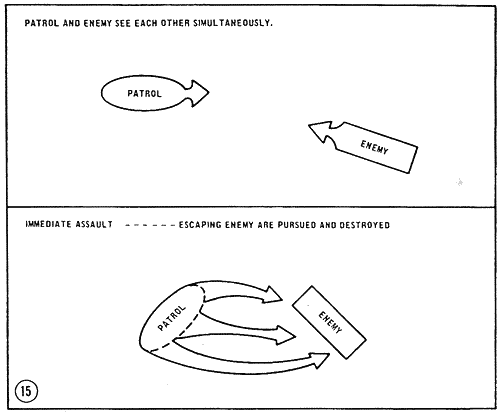
- Situation. Patrol is ambushed (near
ambush).
- Immediate action drill. COUXTER-AMBUSH. Men in killing zone assault to destroy attack force. Other men attack, as directed, to eliminate ambush.
- Subsequent action. Escaping enemy
is pursued and destroyed (16, fig. 95).

- Situation. Patrol is ambushed (far ambush).
- Immediate action, drill. COUNTER-AMBUSH. Men in killing zone return fire. seek cover, continue firing. Other men attack, as directed, to enable men in killing zone to maneuver. All attack, as directed, to eliminate ambush.
- Subsequent action. Escaping enemy
is pursued and destroyed (17, 18, fig.
95).
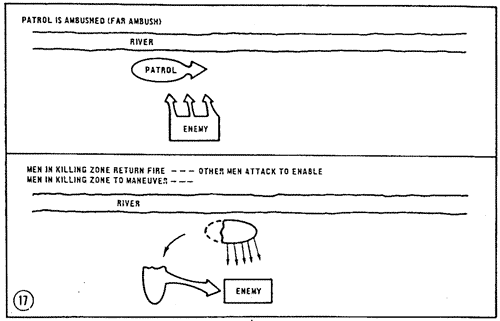
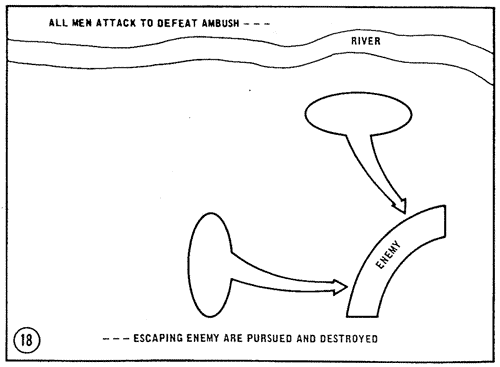
- Situation. Patrol sees enemy approaching. Possibility appears
good that the enemy will not detect patrol. Enemy is
so close that there is no time to establish
a hasty ambush.
- Immediate action drill used not affected by
assigned mission.
- Situation. Aircraft (enemy or unidentified) which may observe
patrol is sighted or heard.
- Immediate action drill. FREEZE, initiated by first man sighting or hearing aircraft.
- Subsequent action. As directed by patrol leader.
- Situation. Enemy aircraft makes low
level attack.
- Immediate action drill. AIRCRAFT ATTACK, initiated by first man detecting aircraft approach.
- Subsequent action.
- Continue mission, if aircraft does not repeat attack.
- Continue dispersion and seek more
cover if aircraft returns or if more
than one aircraft attacks (19, fig.
95).
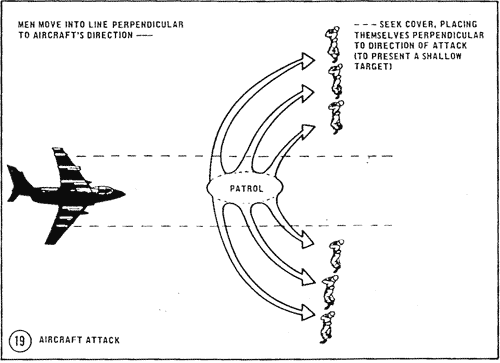
- Situation. Aircraft (enemy or unidentified) which may observe
patrol is sighted or heard.
- Use of Immediate Action Drills
- Some immediate action drills may be used repeatedly with little danger that frequent use will enable the enemy to develop effective counter-measures. FREEZE and HASTY AMBUSH are in this category. The situations in which their use is appropriate do not lend themselves to easy conversion by the enemy into a baited trap.
- Habitual use of some immediate action drills can be very dangerous, however. For example, too frequent use of IMMEDIATE ASSAULT can lead the enemy to expose a small force to an apparently undetected patrol, causing the patrol to launch an IMMEDIATE ASSAULT into the massed fires of a larger, concealed force. This countermeasure has been very effectively used by the Viet Cong guerrillas in South Vietnam.
- Any immediate action drill must be carefully
studied to detect any potential dangers which may
arise from frequent use. If these dangers cannot
be eliminated, the drills must be varied to avoid
setting patterns.


